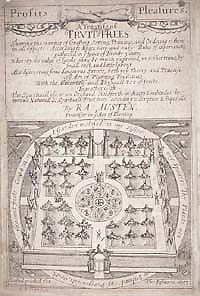In February 1652, Ralph Austen
(c.1612-76)
made contact with Samuel Hartlib, seeking the publication of a book on fruit trees which he was
preparing, and expressing the hope that Parliament might give its support to it. Austen was a
practising nurseryman, who had grown up in Leek in Staffordshire, but had been based in Oxford since
1646. A keen supporter of religious and political reformation, whose mother was a cousin of Henry
Ireton, Austen acted as a secretary to the Parliamentarian Visitors of the University of Oxford from
1648, and was appointed their registrar in 1650. He was thus closely involved with the expulsion of
opponents of the new settlements in church and state from the University, and with the continued
monitoring of educational standards and political obedience there.
During the 1650s, Austen kept a small nursery in Oxford, but his plans to
enclose part of Shotover forest in 1655 failed because he lacked the capital necessary to buy out the
rights of local commoners. Thereafter, he unsuccessfully sought the patronage of Major-General
Fleetwood, having petitioned Parliament to promote the planting of fruit trees just before the death
of Cromwell in 1658. Austen set up a cider factory in Oxford in 1659, and made a living through his
continuing activites as a gardener, planter, and nurseryman. As well as corresponding about fruit
trees, Austen shared the more general concern of many members of the Hartlib circle that new crops
and horticultural practices should alleviate poverty and unemployment.
Austen's practical experience as a nurseryman made his reactions to the growing literature of
improvement particularly interesting to Hartlib, and the two men corresponded extensively in 1652 and
1653 about the progress of Austen's Treatise of Fruit-
Trees, which was eventually published in June 1653,
together with The Spiritual Use of an
Orchard. In the copy here, the two works are bound
together, as the signatures of their sheets suggest they were supposed to be. It seems likely that
they were printed simultaneously; certainly, the delay in publication was caused by problems with the
engraving of the frontispiece, rather than by the author or printer. As late as May 1653, Austen was
complaining to Hartlib about the difficulties he was having with John Goddard, the engraver who was
supposed to cut a brass plate for the title-page. Some resolution must have been achieved, however,
since Goddard's name signs the finished engraving of an enclosed orchard and garden, which follows
Austen's original design. The title-page refers to the Song of Solomon 4:12-13, 'A garden inclosed is
my sister, my spouse; a spring shut up, a fountain sealed. Thy plants are an orchard of pomegranates,
with pleasant fruits'; it is set beneath a device which shows profits shaking hands with pleasures.

The iconography of the frontispiece is taken up in the themes of Austen's
text. This describes the propagation and care of fruit trees, and the benefits which will accrue to
the Commonwealth from keeping them. Its experimental and horticultural discussions are accompanied by
extensive spiritual meditations, which may be drawn from trees and from orchards to improve the soul
of the husbandman. Austen's Treatise of Fruit-
Trees was dedicated to Hartlib, and included extensive
comment on modern books of husbandry which Hartlib had sent to its author (such as Blith's
English Improver Improved, see catalogue no. 15 ), as well as discussion of classical agriculture. It argued
that the true, ancient husbandry had not consisted simply of tillage, but had also included
horticulture, which had been Adam's original employment in Eden, before 'he was put away from this
worke to till the ground, a lower and inferior labour' (sig.4recto). Viticulture had been restored by Noah,
Austen argued, and the Bible provided plenty of historical examples of the advantages of growing
plants and trees. Such activity was profitable and it also generated fruit which was beneficial to
health. Moreover, the husbandman in his orchard had constant opportunity to meditate on the Fall and
on original sin, 'whereof we were all guilty in such a
Place' (p.32), encouraging him to turn his skills and his
profits to the public good.
In Austen's writings, the teachings of the book of nature (the spiritualized
orchard) and of the book of scripture are shown to be in close harmony. Biblical history is deployed
to justify a particular approach to improvement, and to suggest that bodies and souls, as well as
material conditions, can be returned to a paradisical state through prudent and devout activity. |
Falconer Madan, Oxford Books: a Bibliography of Printed Works Relating to the University and City of Oxford (3 vols, Oxford, 1895–1931), vol. 3, pp.26–27; Charles Webster, The Great Instauration (London, 1975), pp.477–80 &546–8; James Turner, ‘Ralph Austen, an Oxford Horticulturalist of the Seventeenth Century’, Garden History, vol. 6 (1978), pp.39–45; Montagu Burrows (ed.), The Register of the Visitors of the University of Oxford, from A.D. 1647 to A.D. 1658 (Camden Society, New Series,vol.29,1881);HartlibPapers,41/1/2A–13B,41/1/26A–29B,41/1/96A–97B,41/1/114A–115B,41/1/121A–122B, 41/1/146A–B, 57/5/5A–B.
|





